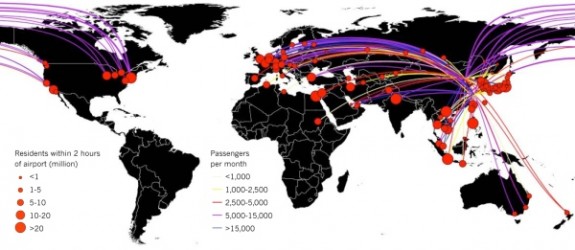This Is How the New Bird Flu Could Get to You
If H7N9 learns to transmit from person to person, here is how it could spread around the world

As far as we know H7N9 cannot be passed directly from person to person. But if it could, this map shows how it could spread from the epicenter of the disease in eastern China. Photo: A. J. Tatem, Z. Huang and S. I. Hay / Nature
So far as we know, China’s deadly new strain of bird flu—H7N9, which was so far killed 22 and infected 104, all in China—can’t pass directly from person-to-person. But if it could, says Oxford University’s Jeremy Farrar to Nature, this unnerving, if speculative, map shows how it could spread.
According to the researchers, the map highlights how the area of China where H7N9 is showing up is also a hub for international air travel. “A quarter of the global population outside of China lives within two hours of an airport with a direct flight from the outbreak regions, and 70 percent if a single connecting flight is included,” they explain.
Over the past couple months, this strain of flu has spread from Shanghai, where it was first found, up to Beijing. In the past nine days, nine more deaths have been attributed to the virus. According to the World Health Organization, says CNN, H7N9 is “an unusually dangerous virus for humans.” The pool of people affected has so far remained relatively small. But there is enough unknown about the new bird virus to have scientists worried.
“So will H7N9 prove to be controllable? Will it remain entrenched in animals? Or will it, like the H1N1 virus, stably adapt to humans and cause a pandemic?” asks clinical researcher Peter Horby in an opinion story in Nature. His assessment isn’t exactly reassuring:
“The fine line between foresight and alarmism can only be drawn in retrospect. Nevertheless, my colleagues and I consider that H7N9 has many of the traits that make a new flu virus worrisome.”
More from Smithsonian.com:
/https://tf-cmsv2-smithsonianmag-media.s3.amazonaws.com/accounts/headshot/smartnews-colin-schultz-240.jpg)
/https://tf-cmsv2-smithsonianmag-media.s3.amazonaws.com/accounts/headshot/smartnews-colin-schultz-240.jpg)